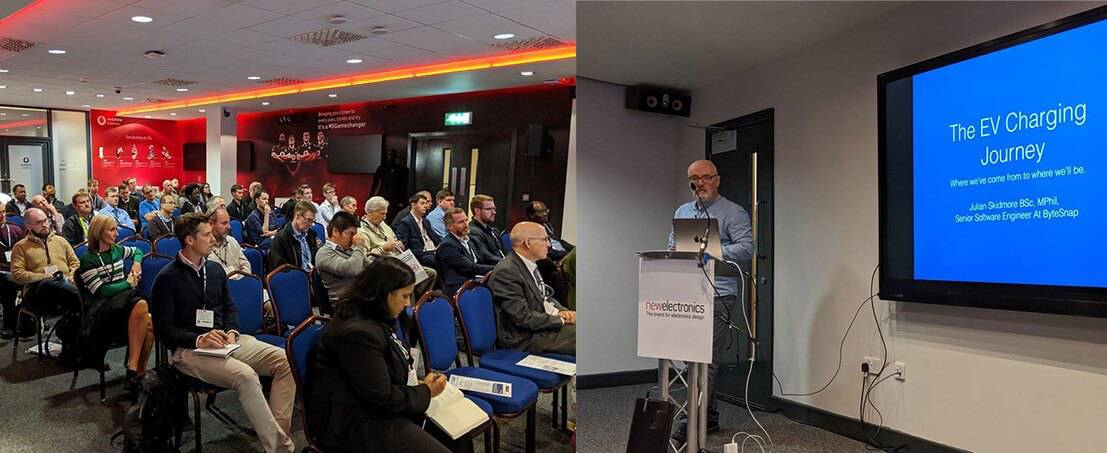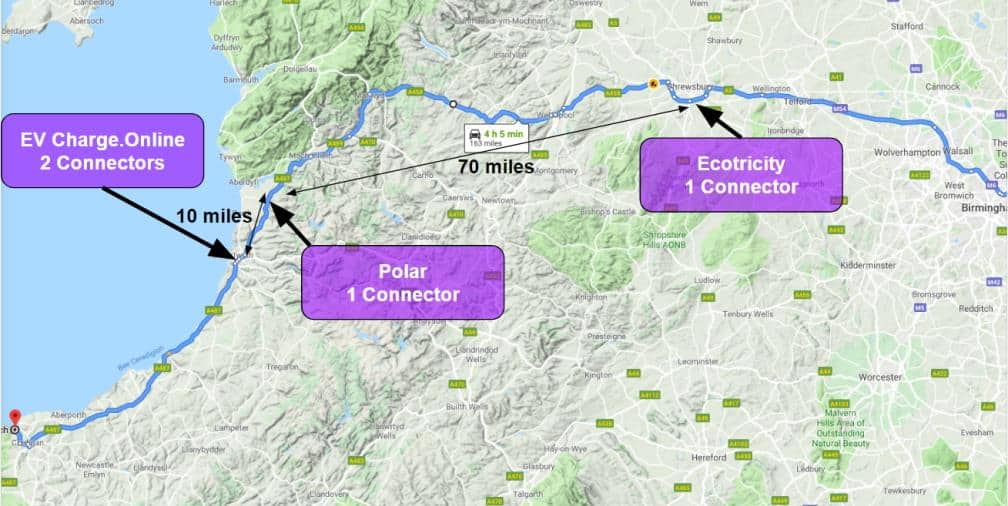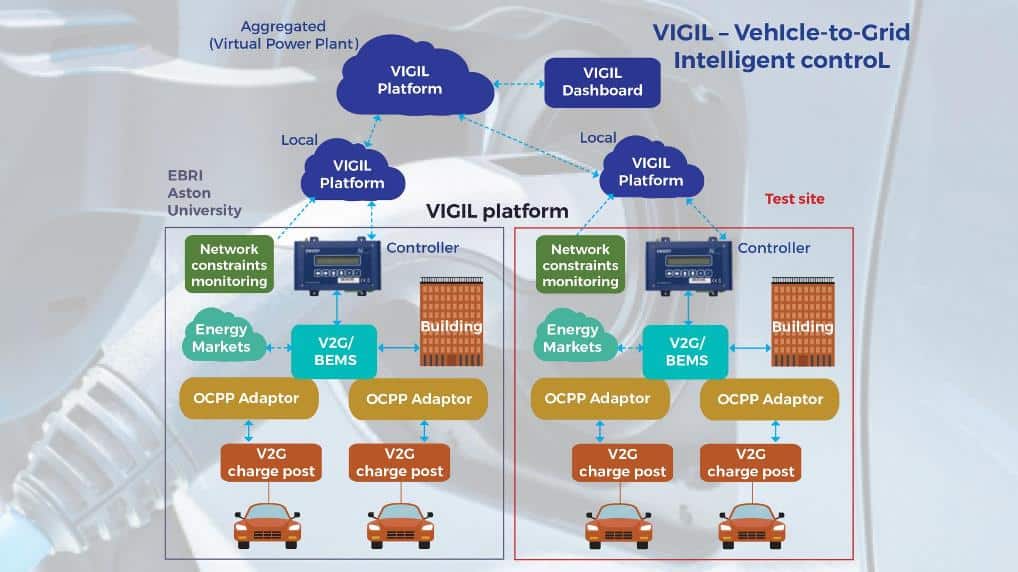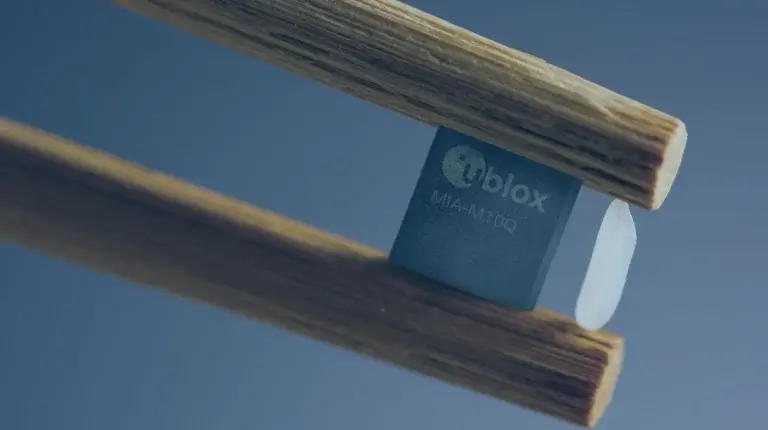UK Electric Vehicle charging…what does the future hold?
Our very own Senior Software Engineer Julian Skidmore, recently presented on the challenges the UK charging infrastructure faces in light of growing EV adoption. Here’s what he had to say….

Since Tesla picked up the torch over a decade ago electric vehicle development has progressed at an accelerating pace. Driven by concerns over global heating and improvements in battery technology, electric vehicles are the most promising solution for emissions-free transit for people and goods. One barrier to EV adoption, however, is the slower-developing EV charging infrastructure which can be inconsistent and difficult to use.
Electric vehicles are now selling in their millions. Tesla launched their high-priced Roadster in 2008 but has followed with more competitively priced EVs like the Model 3. Mainstream manufacturers Nissan, Renault and BMW launched the Leaf in 2010, the Zoe in 2012, and i3 in 2013. Twenty two BEV models are now available, from twelve different manufacturers, expanding to 53 from 23 manufacturers in 2020 including most brands from Porsche to Skoda with prices or performance that can compete with diesel- and petrol-powered vehicles.
EV ownership is growing rapidly
A survey of UK adults conducted earlier this year by Opinium and Pure Planet showed that 43% would consider driving an EV. Research by the AA in 2018, with over 10,000 drivers polled, found that half of young people in the UK would like to own an electric vehicle.
Total BEV sales in the UK have accelerated from 31,889 in 2016 to 45,486 in 2017, to 60,960 in 2018 and is projected to reach 100,000 by the end of 2019 based on SMMT archives. The government has set a goal for half of all new vehicle sales by 2030 to fall into the “ultra-low” emissions category, yet at current growth rates over 2010 to 2019, all registered vehicles will be BEVs by the mid-2020s as they address remaining concerns.
One top concern vehicles can’t address themselves is the availability of public charging points. The AA survey, found that 85% of respondents didn’t think there were enough.
Will charging availability and technology hold back EV adoption?
Indeed, the charging of electric vehicles currently presents a barrier to their adoption. While battery capabilities have grown rapidly, from a range of 100 miles to between 200 and 300 miles today; EV prices are falling, consumer choice is growing, and EV performance is rising. So how can EV charging infrastructure keep up?
AC/DC Charging
AC chargers, like those at home, with slower charging and lighter loading are best for grid management with local or urban driving. That’s because most journeys are short, so their energy requirements won’t change over time. Home charges obviously keep up with EVs sold, but public ones currently aren’t and so they should be targeted, because they’re cheap and cover the majority of cases.
However, rapid DC chargers are essential for longer journeys and rollout is catching up. This is because charging rate has a much larger impact on average speeds than battery size.
If we want to put our EVs on the highway, rapid charging matters more than a large battery, but for local or urban driving there will be a market for smaller batteries, slow charging EVs. This is borne out by the fact that some of the new cars in 2020, the Seat Mii, Skoda CityGoe4 and VW e-UP 2.0 will have modest batteries, short ranges and 7KW charging as standard.
User experience
EV chargers are surprisingly less user-friendly than we’d expect from something that is powering our driving future. Payment methods can be inconsistent and billing mechanisms “nasty”; connections can be faulty or intermittent; systems can crash and user interfaces have even been found to be on the opposite side of the charger from the plug.
For instance, an example of these issues from a recent trip I made in my 22KWh Zoe – where at the first (50mi) stop, we had to wait 30 minutes for a Nissan Leaf to charge. Then…

…the next rapid charging point was 70 miles away across the Welsh mountains, it was a type we’d used before, the car reported a fault when trying to connect; so then we had to drive another 10 miles to Aberystwyth for a 22KW AC charger which had a web interface that required pre-payment. Frustratingly, the identifiers for the charging points didn’t match the information on the screen, which also kept scrolling out of view and the post only provided a few LEDs to help.
We wouldn’t accept this lack of service at a petrol station. EV journeys really shouldn’t have to be that stressful.
Infrastructure
We are at the beginning of the EV revolution, and this presents an opportunity without the constraints of fossil fuel-powered cars which need piping, tankers, stations, and Just In Time logistics.
However, better government support and initiatives may be needed to support charging locations and a good geographic availability of chargers. Subsidies for charging network providers may also be needed while the EV economy stabilises.
There is also an issue of load balancing as distributed energy may cause intermittent supply. Usage restrictions and non-standardised interfaces represent wasted engineering effort that actually slows down adoption.
Lastly, charging points are unmanned resulting in maintenance issues but perhaps presenting an opportunity for a new service industry.
Communications protocols
Charger manufacturers would like a comprehensive networking protocol between the charger and the car, but the IEC 61851 and 62196 specifications have led to a plethora of (crude) PWM, CAN bus and IP over Power communications along with incompatible plugs. In addition, a reluctance of manufacturers to provide useful EV battery charging states (to protect their patents) will continue to inhibit the potential for Smart EV charging.
Innovative solutions – Vehicle to Grid (V2G) technology
Electric Vehicles can be part of the energy solution, because batteries also represent a source of base-load microgeneration.
ByteSnap, in collaboration with Aston University and consortium of other partners is part of a two-year project called VIGIL (Vehicle-to-Grid Intelligent Control). VIGIL will see the development of a new communication and control platform for vehicle-to-grid (V2G) and vehicle-to-building (V2B) systems.
V2G technology could mean that electric vehicles can return energy to the power grid when stationary and plugged in, increasing energy grid resilience and providing payback for EV drivers. V2G connectivity could also take advantage of the new phenomenon of renewable energy surplus, which has happened numerous times across Europe. Germany is the most frequent benefactor of this amazing scenario where too much green energy is available and consumers can experience negative energy prices.

VIGIL would promote comprehensive charging communications, in turn aiding EV adoption, with ByteSnap’s smart communications controller (called RAY) managing the charge going back into the smart building, or substation. In turn, substation energy can flow into the smart building; charge EVs or return power to the grid.
The future of EV charging
To further improve the provision of EV charging and deliver solutions to allow EVs to successfully scale, there are many other ideas and developments in the EV charging space.
Appless charging, where EV owners can tap a credit or debit card on a charging post to start and stop charging is something every EV driver would like and is becoming available. Some Polar Ultrachargers have a contactless payment method and Ecotricity Electric Highway plan a similar upgrade, even though it will result in higher charging costs.
Combining substations with urban car parks could help solve issues of kerb-based charging sockets which can be inaccessible or easily damaged.
We could knock down a house in a street (there’s always someone who wants to sell theirs) and replace it with a secure multi-storey car park with built-in charging facilities. The infrastructure stays in one place so it’s much cheaper to implement, upgrade and maintain; streets are cleared of EVs; the car park provides security; V2G facilities, load balancing etc.
Fully automated charging is the ultimate ideal, perhaps in the form of robots plugging in charging cables, but more likely, inductive charging though this requires charging mechanisms to change yet again and therefore may be some time in the future.
At the end of my presentation titled “The EV Charge Point Journey: What’s the Final Destination?” I concluded that EVs are the technology most likely to replace fossil-fuelled vehicles and that:
The nascent world of EVs is a rapidly accelerating, disruptive market; and charging technology and infrastructure is as critical to their deployment as the vehicles themselves.
The challenge for UK government and industry, and for other countries around the globe, is to not only to drive the development of EVs but also the charging infrastructure and supporting systems in order make EV driving as effortless and attractive as driving a petrol or diesel vehicle.
To find out more about how ByteSnap can help charging infrastructure companies during their journey, please visit https://www.bytesnap.com/products/smart-charge-point-communications-controller/
How can ByteSnap help you today?
From start-ups to blue chips, ByteSnap’s embedded systems software developers are enabling companies to stay a step ahead by providing them with bespoke solutions. Maintain your competitive edge – contact us today and let your business be among them!




